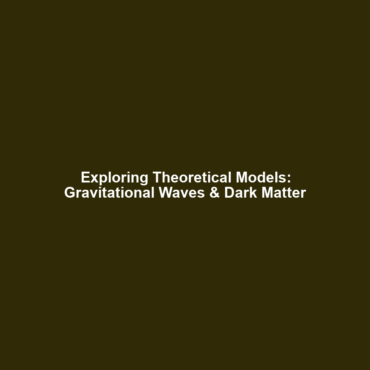Theoretical Models Connecting Gravitational Waves and Dark Matter Candidates
Introduction
The study of theoretical models connecting gravitational waves and dark matter candidates has become a pivotal aspect of modern astrophysics. Understanding how these two enigmatic phenomena interrelate could unlock significant insights into the structure and evolution of the universe. Gravitational waves, ripples in spacetime caused by massive cosmic events, not only provide evidence of black holes and neutron star mergers but may also reveal the nature of dark matter—one of the most profound mysteries in contemporary science. This synthesis of gravitational wave detection and dark matter candidates may ultimately revolutionize our comprehension of the cosmos.
Key Concepts
To comprehend the connection between gravitational waves and dark matter candidates, it’s essential to explore several key concepts:
Gravitational Waves
Gravitational waves are produced by accelerating masses, predicted by Einstein’s General Theory of Relativity. Their detection confirms the existence of phenomena like binary black hole mergers, which help physicists understand fundamental aspects of gravity and spacetime.
Dark Matter Candidates
Dark matter, constituting approximately 27% of the universe, remains invisible and undetectable through electromagnetic radiation. Various candidates, including Weakly Interacting Massive Particles (WIMPs) and axions, are theorized to explain dark matter’s elusive nature.
Theoretical Connections
Theoretical models propose that interactions between dark matter and gravitational waves might occur under specific conditions, enabling the detection of dark matter properties through gravitational wave observations.
Applications and Real-World Uses
Theoretical models linking gravitational waves and dark matter candidates play a crucial role in various applications within the field of astrophysics:
- Detection Methods: Innovative approaches utilize gravitational wave data to infer the existence of dark matter, aiding in the identification of its properties.
- Cosmological Studies: Understanding the behaviors and interactions of dark matter allows researchers to make predictions regarding cosmic evolution and formation.
- Astrophysical Simulations: Advanced simulations leveraging these theoretical models aid in visualizing how dark matter influences gravitational wave emissions during cosmic events.
Current Challenges
Investigating the connections between theoretical models connecting gravitational waves and dark matter candidates faces multiple challenges:
- Detection Sensitivity: Current detectors may not be sensitive enough to identify signals linked to dark matter.
- Data Interpretation: The complexity of gravitational wave data can lead to misinterpretations regarding dark matter interactions.
- Theoretical Uncertainties: Variability in the properties and behaviors of dark matter candidates complicates modeling efforts.
Future Research and Innovations
As research continues, several innovations are on the horizon regarding theoretical models connecting gravitational waves and dark matter candidates:
- Enhanced Detection Algorithms: Developing sophisticated algorithms for disentangling gravitational wave signals could lead to improved detection of dark matter signatures.
- Next-Generation Detectors: Building advanced detectors such as LIGO and Virgo upgrades may increase sensitivity and enhance our understanding of dark matter.
- Interdisciplinary Approaches: Collaborations across astrophysics, particle physics, and computational modeling are expected to yield significant breakthroughs.
Conclusion
Theoretical models connecting gravitational waves and dark matter candidates offer promising avenues for understanding fundamental cosmic mysteries. By integrating these concepts, researchers may unlock vital insights into the universe’s structure and origin. Ongoing and future studies are crucial for elucidating this intricate relationship, and continued investment in research and technology is essential for progress. For further exploration of this topic, visit our related articles on gravitational wave detection and dark matter research initiatives.

Leave a Reply